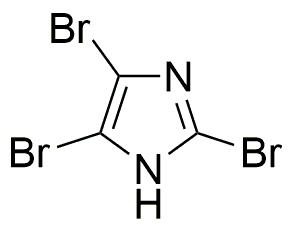2,4,5-Tribromoimidazole is widely utilized in research focused on:
- Antimicrobial Agents: This compound is effective in developing new antimicrobial agents, particularly in combating resistant bacterial strains, making it valuable in pharmaceutical research.
- Biocides: It serves as a potent biocide in agricultural applications, helping to protect crops from harmful microorganisms while minimizing environmental impact.
- Polymer Chemistry: Used in the synthesis of specialty polymers, it enhances the properties of materials, leading to improved durability and resistance to degradation.
- Research Reagents: As a reagent in various chemical reactions, it aids researchers in synthesizing complex molecules, facilitating advancements in organic chemistry.
- Environmental Applications: Its role in environmental science includes the development of compounds for pollutant degradation, contributing to cleaner ecosystems.
General Information
Properties
Safety and Regulations
Applications
2,4,5-Tribromoimidazole is widely utilized in research focused on:
- Antimicrobial Agents: This compound is effective in developing new antimicrobial agents, particularly in combating resistant bacterial strains, making it valuable in pharmaceutical research.
- Biocides: It serves as a potent biocide in agricultural applications, helping to protect crops from harmful microorganisms while minimizing environmental impact.
- Polymer Chemistry: Used in the synthesis of specialty polymers, it enhances the properties of materials, leading to improved durability and resistance to degradation.
- Research Reagents: As a reagent in various chemical reactions, it aids researchers in synthesizing complex molecules, facilitating advancements in organic chemistry.
- Environmental Applications: Its role in environmental science includes the development of compounds for pollutant degradation, contributing to cleaner ecosystems.
Documents
Safety Data Sheets (SDS)
The SDS provides comprehensive safety information on handling, storage, and disposal of the product.
Product Specification (PS)
The PS provides a comprehensive breakdown of the product’s properties, including chemical composition, physical state, purity, and storage requirements. It also details acceptable quality ranges and the product's intended applications.
Certificates of Analysis (COA)
Search for Certificates of Analysis (COA) by entering the products Lot Number. Lot and Batch Numbers can be found on a product’s label following the words ‘Lot’ or ‘Batch’.
*Catalog Number
*Lot Number
Certificates Of Origin (COO)
This COO confirms the country where the product was manufactured, and also details the materials and components used in it and whether it is derived from natural, synthetic, or other specific sources. This certificate may be required for customs, trade, and regulatory compliance.
*Catalog Number
*Lot Number
Safety Data Sheets (SDS)
The SDS provides comprehensive safety information on handling, storage, and disposal of the product.
DownloadProduct Specification (PS)
The PS provides a comprehensive breakdown of the product’s properties, including chemical composition, physical state, purity, and storage requirements. It also details acceptable quality ranges and the product's intended applications.
DownloadCertificates of Analysis (COA)
Search for Certificates of Analysis (COA) by entering the products Lot Number. Lot and Batch Numbers can be found on a product’s label following the words ‘Lot’ or ‘Batch’.
*Catalog Number
*Lot Number
Certificates Of Origin (COO)
This COO confirms the country where the product was manufactured, and also details the materials and components used in it and whether it is derived from natural, synthetic, or other specific sources. This certificate may be required for customs, trade, and regulatory compliance.


